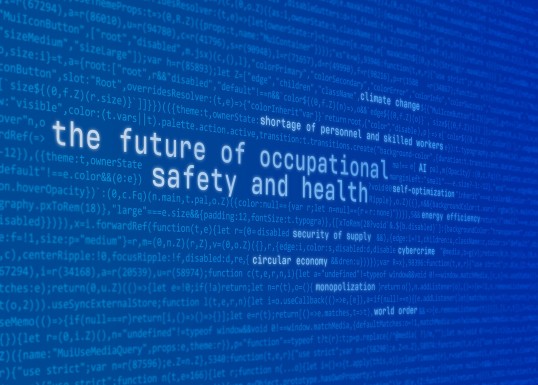- Artificial Intelligence (AI)
- Occupational exposure limit values
- Climate Change and Occupational Safety
- List of CMR substances
- Electromagnetic fields
- Ergonomics
- Industrial Security
- Collaborative robots
- Noise
- Nanoparticles at the workplace
- Optical Radiation
- REACH
- Reference materials
- Proficiency testing
- Vibration
- Virtual reality
- Work 4.0
The Risk Observatory
Priorities for the occupational safety and health of tomorrow

One purpose of the German Social Accident Insurance’s Risk Observatory is for instance to examine how technological and social developments impact upon safety and health at work.
Source: DGUV
If human factors are to be considered in the shaping of work in the future - all the more so in changing times - we must be aware of what awaits us. The early detection of trends in the world of work is important in this context. The DGUV Risk Observatory, located at the IFA, is one such early detection system.
The survey conducted recently by the Risk Observatory identified a number of trends that will be of particular relevance to the work of the German Social Accident Insurance in the coming years. These trends and their impact on occupational safety and health are described in a new trend portal.
Focus on trends
By monitoring and analysing trends, the Risk Observatory identifies key topics for occupational safety and health:
- What trends in particular will shape the world of work and education in the coming years?
- Which of these trends impact upon the safety and health of insured persons?
- What specific risks and opportunities arise as a result?
- What are the resulting findings and perspectives for occupational safety and health?
These four questions are at the heart of the Risk Observatory’s evaluations. The analysis method and its sequencing are described in detail under Methodology of the Risk Observatory.
The results obtained by the Risk Observatory serve as starting points for networking, dialogue and cooperation within the German Social Accident Insurance and with external partners. They facilitate the setting of priorities and pooling of experience. This in turn saves resources and avoids duplication of effort.
The Risk Observatory over the years
The Risk Observatory was established at the IFA in 2011, and is currently in its third survey cycle. The results of the first two survey cycles are still available online (see the "Publications" service box); however, they must be viewed against the backdrop of developments and knowledge at the time. The results of the current, third survey round include the collection of trends and descriptions of top trends, which are presented for the first time in a trend portal.
HTML
Further information

Scientific Publications:
Hauke, A.; Flaspöler, E.; Neitzner, I.; Reinert, D.:Trend analysis by risk observation: how the German statutory accident insurance prepares for the future in occupational safety and health. Saf. Health Work (2022)
Hauke, A.; Flaspöler, E.; Reinert, D.: Proactive prevention in occupational safety and health: how to identify tomorrow's prevention priorities and preventive measures. Int J Occup Saf Ergon (2018)
Reinert, D.: The future of OSH: a wealth of chances and risks. Industrial Health 54 (2016), pp. 387-388
Results of online survey II:
Arbeitswelten. Menschenwelten. Prioritäten für den Arbeitsschutz von morgen (German only)
Results of online survey I: